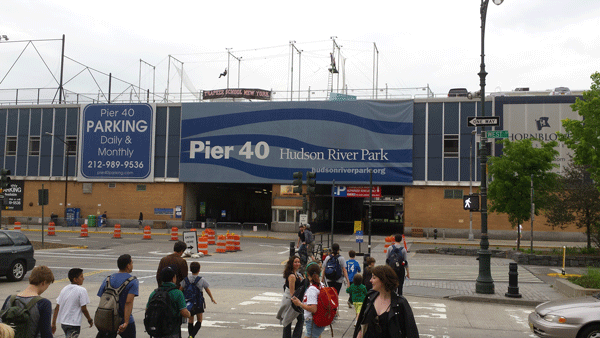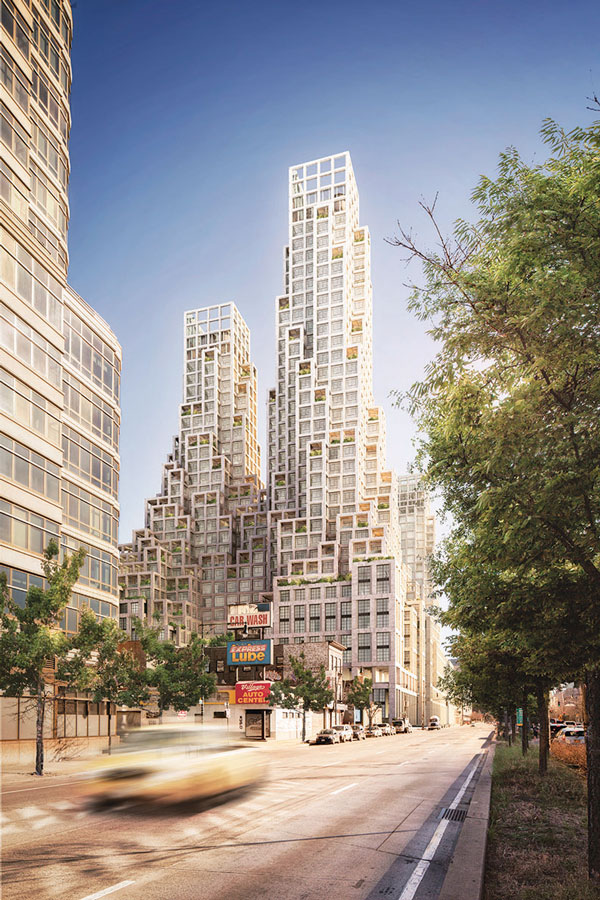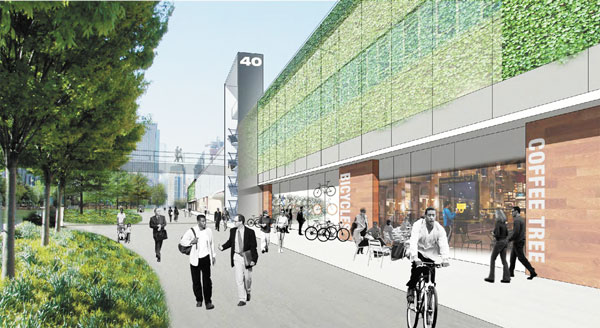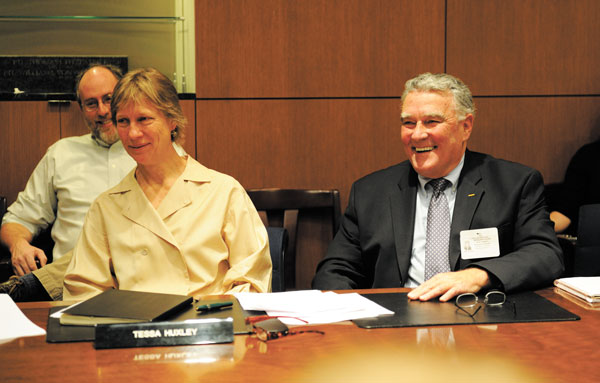
BY LINCOLN ANDERSON | An appraisal firm has pegged the value of the 200,000 square feet of development rights that are planned to be transferred from Pier 40 to the St. John’s Center site at $74.7 million, or $373 per square foot.
The Hudson River Park Trust — which runs the Hudson River Park, in which Pier 40 is located — was legally required to do the appraisal under the state’s Public Authorities Law.
The transferred air rights are planned to be used in the massive St. John’s Partners development project, which would be built on the current St. John’s Building site across the West Side Highway from Pier 40. The project’s total size would be 1.7 million square feet, with 1.3 million of that residential, and 400,000 square feet commercial. There would be an estimated 1,586 residential units, with 476 of those permanently affordable. Of the affordable units, 175 would be set aside for low-income seniors while the rest would be for low- and moderate-income families. The inclusion of so much affordable housing is partly what accounts for the Pier 40 air rights’ relatively low appraisal price.
A rezoning of the St. John’s site is first required to allow the development project to proceed. With the air-rights price appraisal now completed, the application for the St. John’s Partners project is set to be certified by the city’s Department of City Planning on Mon., May 9.
That, in turn, will trigger the start of the seven-month-long Uniform Land-Use Review Procedure, or ULURP, process that will see the project reviewed by Community Board 2, the borough president and City Planning and ultimately voted on by the City Council.
The project’s developer is St. John’s Partners, which is comprised of the site’s owners, Atlas Capital Group, LLC and Westbrook Partners. They have previously agreed to pay the Trust $100 million for the 200,000 square feet of park air rights. Under the 2013 amendment to the Hudson River Park Act that allowed the park to sell off its unused air rights, this payment would have to be funneled directly back into the repair of Pier 40, the ailing 14-acre mega-pier that is Downtown Manhattan’s treasured youth sports nirvana.
The area’s local politicians had requested that the Trust let them see the appraisal when it was completed, and they recently received a copy of the 180-page report. State Senator Daniel Squadron’s office, in turn, this week forwarded to The Villager the report’s five-page executive summary, which outlines how the appraisal figure was arrived at.
Basically, the appraisal starts with the premise that the unused Pier 40 air rights can only be transferred to one site, the St. John’s property. This is because this is the deal that the city supports.
As part of the process, the appraiser — the firm Appraisers and Planners Inc. — first calculated the market value of the 200,000 square feet of Pier 40 air rights as if it were part of the underlying property, the St. John’s site. The developer had initially planned for the market-rate units to be rental, under which the developer would have benefited from tax breaks under the 421-a program. However, since 421-a was not renewed, the appraiser then looked at “the highest and best use” of the market-rate units — i.e. what would yield the greatest profit — and determined that to be condos.

In addition, the St. John’s site includes three sections — a north, center and south section. The north and center sections are planned for residential development, while the south section will probably be a hotel. Again, since residential is considered “the highest and best use,” the appraiser looked at all the 200,000 square feet of air rights in light of their being used on the north and center sites, which is, in fact, the developer’s plan.
Of the 1.3 million square feet of residential development, 74.5 percent would be market-rate condos, about 17 percent affordable units and 8.5 percent senior affordable units. Under the analysis, the market-rate units would have a market value of $825 per square foot, but the affordable units would have a negative “value,” in that they would not be profitable. The senior affordable units were appraised at -$58 per square foot and the straight affordable units at -$208 per square foot. If 421-a still existed, the straight affordable units would not have such a negative value since the developer would get tax credits for building them. Given the breakdown of the project’s rental structures, the market value of the air rights — described as a “blended value” — was appraised at about $114.9 million, or $574 per square foot.
However, under the next step in the process, the appraiser then looked at the 200,000 square feet of air rights in terms of a “ratio” — namely, a comparison to other similar recent air-rights transfers in New York City. Coupled with the fact that the air rights can only be sold to the St. John’s site, this reduced their market value to $74.7 million, or $373 per square foot — only about 65 percent of the initial figure.
“The senior affordable and low-income affordable components produce negative values, indicating that development of these components costs more to develop than their appraised value indicates,” the report states. “In addition…the limited market of both granting and eligible parcels for Pier 40 air rights…yields an applicable ratio of 65 percent… .”
According to sources familiar with the project, the value of air rights is always less than the value of the land to which they are being transferred. In addition, the appraisal does not determine the actual sale price. Again, by law, the Trust’s board of directors must have the appraisal done; they then must use that appraisal in deciding the ultimate sale price. The number that the Trust has negotiated with St. John’s Partners — and which it has said it is sticking to — is $100 million.
However, that figure is “simply a negotiated number,” according to the sources, and “is not a binding number” on the Trust. The sale price, in fact, cannot be set until the ULURP is approved by the City Council. In addition, under the Hudson River Park Act, the sale of the air rights would be what is known as a “significant action” — because “it’s important and has to do with property.” As a result, the Trust will have to conduct a “Significant Action Process,” meaning all affected community boards must be notified about the project, a public hearing will be held about it and public comment will be received. All of this information and input will then be provided to the Trust’s board of directors, who will then approve the transfer of the air rights and set the sale the price. This would all be a separate process from ULURP, but could happen concurrently with it.
As for why the St. John’s site is the only one authorized to accept the Pier 40 air rights, the sources explained that this is basically how the city plans to handle air rights transfers from the Hudson River Park. In short, the decision was made by the city to review each of these transfers on “a case-by-case basis.” A special zoning district is being put in place to allow the transfer of air rights from the 4.5-mile-long park across the highway to sites within one block of the park. However, according to the sources, “The city wants a nexus between the granting site and the receiving site…wants them to be reasonably proximate.”
Specifically, the Department of City Planning reportedly will require that receiving and granting sites be within one half-mile of each other, or at least within the same community board. So — contrary to what some local activists had wondered might be the case — air rights will not be able to be transferred up and down the length of the park. Air rights may only be transferred from commercially zoned piers.
Following their receipt of the air rights appraisal, the local politicians on May 2 wrote a joint letter to Carl Weisbrod, chairperson of the City Planning Commission, and Madelyn Wils, president and C.E.O. of the Trust. The six pols — Squadron, state Senator Brad Hoylman, Congressmember Jerry Nadler, Assemblymember Deborah Glick, Manhattan Borough President Gale Brewer and Councilmember Corey Johnson — last November submitted joint testimony at the scoping hearing for the St. John’s project, raising a number of concerns about it and requesting more detailed information about the state of Pier 40.
“While we have received the air rights appraisal, we have not yet received a list of the outstanding repairs needed at Pier 40 and their associated costs,” the politicians wrote. “As such, it is still unclear if the proposed payment from the developer to the park of $100 million will be sufficient to cover the necessary repairs to the pier. Therefore, we again request a detailed breakdown of necessary repairs to the pier and their associated costs from Hudson River Park Trust. This is essential information that we, and the community, should know prior to reviewing this ULURP application.
“We also ask that representatives of the Trust and the appraiser attend a Community Board 2 meeting so that community members can ask specific questions about the project, including the air rights, before the ULURP process begins,” the politicians said.
“Additionally, we have not received updates from City Planning on the impact this project would have on school seats, open space, traffic and other items we outline in detail in our testimony. It is imperative that we have this information in order to assess the proposed project. Therefore, we ask that City Planning provide a written response to our questions before May 9.
“Pier 40 is an important resource for Lower Manhattan and all of New York City,” the lawmakers wrote. “We must ensure its continued well-being for future generations of New Yorkers. A fair valuation of the air rights and a robust public examination of the appraisal are a critical first step in securing Pier 40’s future.”
In response to the concerns raised about Pier 40 in the politicians’ letter, Trust C.E.O. Wils said, “In addition to our primary focus of repairing the piles, as requested, we are compiling a list of other potential repairs which may be needed in the next five-plus years.”
According to Wils, Pier 40’s most pressing need is for repair of its scores of corroded steel piles, which hold the pier up over the river.
As for City Planning, Joe Marvilli, the agency’s press officer, responded, “We appreciate the elected officials’ request and we will take into account all comments in our forthcoming public review process.”
Providing a community perspective, Daniel Miller, a leading local youth advocate, said the air rights sale is a good start, yet more will need to be done to ensure Pier 40’s lasting survival. Miller is a member of the Pier 40 Champions youth sports coalition and also of C.B. 2, on which he is on the Pier 40 / St. John’s Air Rights Task Force.
“The appraisal of $74 million is not utterly surprising, given the amount of affordable housing units in the development,” Miller said. “And in many respects, it is inconsequential, given the deal to transfer $100 million will not be affected by the appraisal.
“The bottom line for me is to guarantee not only the future of Pier 40, but the park as a whole,” he said. “As advocates for the health of Pier 40 and the open space it provides as athletic fields, the Trust is in desperate need for funds to repair the piles that support the pier. Without this infusion of funds from the St. John’s development, Pier 40 will be condemned. But let’s consider if all goes according to plan. What happens next, after the $100 million in air rights transfer funds is spent fixing underwater piles, but the infrastructure of the above-water pier continues to rot?”
In short, Miller said, what the Trust is doing at Pier 57 in Chelsea could be a model for Pier 40. In other words, the Village pier will need some more commercial uses beyond its current parking operation, so that it can generate an additional stream of ongoing revenue to help keep the pier afloat into the future.
“We need a plan that will ensure the longevity of the pier for generations to come,” he said. “Pier 57’s success in finding a top-tier tenant in Google should be used as an example of forward-thinking stewardship. The act governing Pier 40 should be revised to include office space, which bears a lower impact than residential or retail.”
(Ironically, three years ago when Pier 40 Champions was pitching an idea to build twin luxury high-rise towers right next to the pier to raise cash for the pier, developer Douglas Durst was pushing an opposing plan — namely, to convert the existing Pier 40 shed structure into offices. Desperate youth sports advocates — feeling the towers plan was their best chance to save the pier, and fearing Durst was undermining their efforts — angrily lashed out at him at a public hearing at which the two competing plans were presented.)

“Our Downtown youth leagues cannot survive without the fields at Pier 40,” stressed Miller, a past president of the Greenwich Village Little League. “The next request for proposals for Pier 40 should make it clear that the pier’s current ball fields will stay where they are, and not be displaced or interrupted when the inevitable development on the pier is approved. If anything, the R.F.P. should require an increase in footprint [of the ball fields on the pier] to provide more open space for all the new residents that will reside in the new developments.”
Two previous R.F.P. processes by the Trust to find developers for Pier 40 both failed in the face of opposition from the community; local residents feared high-impact commercial uses that would negatively affect both the surrounding community and the pier itself, particularly its Little League and youth soccer programs. The Trust, though, has not said if it plans to issue yet another Pier 40 R.F.P.
On the other hand, some appropriate, low-impact commercial uses could be the pier’s long-term savior, in the opinion of Miller and presumably other youth sports advocates.
“From what I understand, no tax dollars are returned to Hudson River Park,” Miller said. “The Trust’s budget relies on private donations and an unreliable stream from local and state sources. Consider all the park has given back to the city in terms of real estate taxes because new developments [along the waterfront and in neighborhoods near it] would not be as attractive without the park. It’s time our elected officials re-examine how Hudson River Park is expected to stay afloat.
“Hudson River Park is the main outdoor attraction to Downtown West Siders. It deserves our support. We should not allow our most precious resource — our children’s health and the outdoor activities Pier 40 provides — to be condemned.”


















